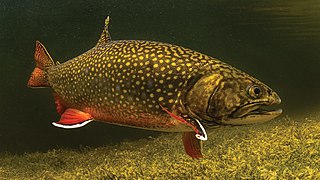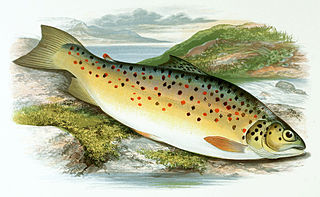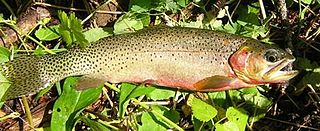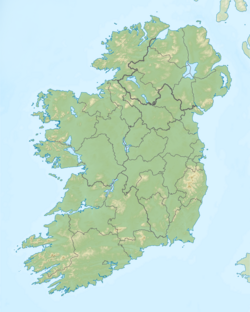
Trout is a generic common name for numerous species of carnivorous freshwater ray-finned fishes belonging to the genera Oncorhynchus, Salmo and Salvelinus, all of which are members of the subfamily Salmoninae in the family Salmonidae. The word trout is also used for some similar-shaped but non-salmonid fish, such as the spotted seatrout/speckled trout.

The bull trout is a char of the family Salmonidae native to northwestern North America. Historically, S. confluentus has been known as the "Dolly Varden", but was reclassified as a separate species in 1980. Populations of bull trout in the lower 48 states are listed as threatened under the U.S. Endangered Species Act, and bull trout overall are listed as vulnerable to extinction on the IUCN Red List of Threatened Species. The Saskatchewan-Nelson Rivers population in Alberta, Canada is listed as threatened under the Species at Risk Act.

The Atlantic salmon is a species of ray-finned fish in the family Salmonidae. It is the third largest of the Salmonidae, behind Siberian taimen and Pacific Chinook salmon, growing up to a meter in length. Atlantic salmon are found in the northern Atlantic Ocean and in rivers that flow into it. Most populations are anadromous, hatching in streams and rivers but moving out to sea as they grow where they mature, after which the adults seasonally move upstream again to spawn.

The brook trout is a species of freshwater fish in the char genus Salvelinus of the salmon family Salmonidae native to Eastern North America in the United States and Canada. Two ecological forms of brook trout have been recognized by the US Forest Service. One ecological form is short-lived potamodromous populations in Lake Superior known as coaster trout or coasters. The second ecological form is the long-living predaceous anadromous populations which are found in northern lakes and coastal rivers from Long Island to Hudson Bay, which are referred to as salters. In parts of its range, it is also known as the eastern brook trout, speckled trout, brook char, squaretail, brookie, or mud trout, among others. Adult coaster brook trout are capable of reaching sizes over 2 feet in length and weigh up to 6.8 kg (15 lb), whereas adult salters average between 6 and 15 inches in length and weigh between 0.5 and 2.3 kg. The brook trout is characterized by its distinctive olive-green body with yellow and blue-rimmed red spots, white and black edged orange fins, and dorsal vermiculation. The diet of the brook trout is restrictive to the season and location of the fish, but will typically consist of terrestrial and aquatic insects, fry, crustaceans, zooplankton, and worms.

The Arctic char or Arctic charr is a cold-water fish in the family Salmonidae, native to alpine lakes, as well as Arctic and subarctic coastal waters in the Holarctic.

Sea trout is the common name usually applied to anadromous (sea-run) forms of brown trout, and is often referred to as Salmo trutta morpha trutta. Other names for anadromous brown trout are bull trout, sewin (Wales), peel or peal, mort, finnock (Scotland), white trout (Ireland), Dollaghan and salmon trout (culinary).

The silver trout is an extinct char species or subspecies that inhabited a few waters in New Hampshire in the United States prior to 1939, when a biological survey conducted on the Connecticut watershed by the New Hampshire Fish and Game Department found none.

The Dolly Varden trout is a species of salmonid ray-finned fish native to cold-water tributaries of the Pacific Ocean in Asia and North America. Despite the name "trout", it belongs to the genus Salvelinus (chars), which includes 51 recognized species, the most prominent being the brook, lake and bull trout as well as the Arctic char. Although many populations are semi-anadromous, riverine and lacustrine populations occur throughout its range. It is considered by taxonomists as part of the Salvelinus alpinus complex, as many populations of bull trout, Dolly Varden trout and Arctic char overlap.

Salvelinus is a genus of salmonid fish often called char or charr; some species are called "trout". Salvelinus is a member of the subfamily Salmoninae within the family Salmonidae. The genus has a northern circumpolar distribution, and most of its members are typically cold-water fish that primarily inhabit fresh waters. Many species also migrate to the sea.

Lough Melvin is a lake in the northwest of the island of Ireland on the border between County Leitrim and County Fermanagh. It is internationally renowned for its unique range of plants and animals.

The gillaroo is a species of trout which eats primarily snails and is only proven to inhabit Lough Melvin in Ireland.

The westslope cutthroat trout, also known as the black-spotted trout, common cutthroat trout and red-throated trout is a species of the cutthroat trout group and is a freshwater fish in the salmon family of order Salmoniformes. The cutthroat is the Montana state fish. This subspecies is a species of concern in its Montana and British Columbia ranges and is considered threatened in its native range in Alberta.

The Sunapee trout, also called blueback trout, Sunapee Golden trout, or Quebec red trout, is a putative subspecies of Arctic char native to northeastern New England in the United States, as well as Québec and New Brunswick in Canada, with introduced populations in Idaho.

A kype is a hook-like secondary sex characteristic which develops at the distal tip of the lower jaw in some male salmonids prior to the spawning season. The structure usually develops in the weeks prior to, and during, migration to the spawning grounds. In addition to the development of the kype, a large depression forms in the two halves of the premaxilla in the upper jaw, allowing the kype to fit into the premaxilla when the mouth is closed.
Salvelinus colii, also called Cole's char, Enniskillen char or Trevelyan's char, is a cold-water species of char fish in the family Salmonidae.
The Coomsaharn char is a species of lacustrine char fish in the family Salmonidae.
Salvelinus obtusus, commonly called the blunt-nosed Irish charr or blunt-snouted Irish char, is a species of lacustrine char fish in the family Salmonidae, found in the Lakes of Killarney, Ireland.
















